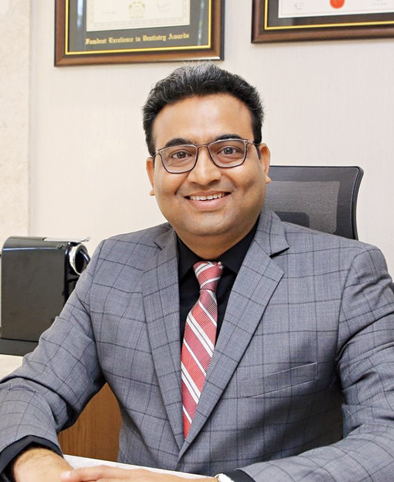“Nothing you wear is more important than your smile”— Connie Stevens, Hollywood actor
What constitutes a perfect smile?
Is it the shape and colour of teeth, the lips or the reflection of ones self, which is unique to every individual. This simple question evokes a varied response ranging from simple beauty tips to deep philosophical insight. What is it about our smile that captivates, disarms and sets sail a thousand ships?
To give a simple scientific answer, a smile is formed primarily by flexing the muscles at the sides and around your lips. Webster defines the smile as “a change of facial expression involving a brightening of the eyes, an upward curving of the corners of the mouth with no sound and less muscular distortion of the features than in a laugh that may express amusement, pleasure, tender affection, approval, restrained mirth, irony, derision or any of various other emotions”.
This innocent feature of the body is accentuated by multiple factors, some of which are physical, like the eyes, the teeth and the shape of the nose and jaws. A smile can further be embellished by confidence, emotional well-being and a zest for life. It is no wonder that it is the perfect gesture of a universal welcome.
What is smile designing?
While we are all endowed with a unique smile, there are many among us who are not happy with the way they smile. The reason could be facial structure or related to the teeth. While dental issues are the primary reason wherein people are not happy about the way they smile, there are many features about the face which can contribute to a less than ideal smile.
Smile designing is a branch of aesthetic medicine where multiple specialists like cosmetic dentists, orthodontists, maxillofacial surgeons, periodontists (gum specialists) and dermatologists have a role in enhancing the face value and confidence of anyone who desires to enhance ones appearance. With latest advances in digital dentistry, CAD CAM technology, 3D printing and material science, we are truly at a crossroads where art meets science in delivering what one desires to change or enhance about their smile.
Ways to correct a smile
Smile correction procedures range from simple tooth chip treatment all the way up to complex structural jaw realignment surgery, depending on the presenting complaint and the detailed assessment by the specialist.
Chipped tooth issues can be managed by a simple bonding procedure where a tooth-coloured material with perfect shade match is used to reconstruct the missing portion of the tooth. Discoloured teeth may be managed with teeth whitening procedures (called dental bleaching) which can be done during a single visit with a one-hour procedure. Discoloured teeth may be due to internal issues with teeth or due to habits like tobacco smoking and chewing, which is extremely common in India.
Many people simply don’t like the look of their crooked smile due to poorly aligned teeth that can also have a negative impact on your oral health, providing crevices for food residue to hide in and making your teeth harder to keep clean. The commonest way to treat crooked teeth are veneers and braces.
Veneers consist of a very thin layer of porcelain, which is placed over your natural tooth to disguise any imperfections. Not only can veneers be used to straighten teeth, they can mask misshapen teeth or teeth that are badly stained and can’t be whitened. The results are impressive — think Hollywood smile — and can be achieved within just a few appointments.
If your teeth are broken or severely decayed then dental crowns made of zirconia, colloquially called caps, are placed over the top of any damaged or broken teeth. They’ll look as good as new, and they’ll function just like your own. In some cases, a combination of crowns and veneers can be employed to create a camera-ready smile. Crowns aren’t designed to last forever, but with good care and oral hygiene they can last up to 30 years before they need replacing. These usually require a couple of visits to fabricate.

Sourced by the correspondent
The ideal treatment for crooked teeth are fixed braces or removable ‘invisible’ braces that can gradually move your teeth to reveal a beautifully straight smile that’s all yours. Braces or aligners aren’t a quick fix though; treatment can take months and occasionally years. Development in artificial intelligence and 3D printing technology has led to ground-breaking developments in braces with the advent of transparent braces called invisible braces or aligners. A set of aligners, which fit like a glove over your teeth, need to be changed by the patient every 10-14 days and this can be done by themselves at home. It’s a boon for people who do not want to wear conventional metallic braces.
Dental implants for missing teeth
Nothing can tarnish a beautiful smile more than a missing tooth. The gaping hole of a missing tooth is akin to a defect in ones persona. With computer-guided implant surgery, it is possible now to restore missing teeth accurately in least number of visits. This is possible due to dental implants which are root-shaped titanium inserts placed into the jaw bone over a simple 10-minute procedure. The insert acts as an anchorage for the future tooth that would be constructed over it in harmony with the remaining teeth and face.
Missing teeth can lead to a loss of jaw bone structure and collapse of lips and cheeks, leading to a typical aged-face appearance. Implants can restore the single to entire set of teeth, including replacing jaw bone structures, thereby restoring the face to normal appearance holistically.
Jaw correction surgery
There are situations where the entire jaw can be misaligned, leading to extremely proclined teeth called buck teeth, or improper bite issues like overbite or underbite. Apart from poor appearance and diminished confidence, symptoms associated with a misshapen jaw can greatly affect an otherwise healthy person.
Speech or chewing issues, chronic headaches or migraines, difficulty sleeping including sleep apnoea, and abnormal tooth wear causing tooth sensitivity are common. Left untreated, the toll taken by TMJ (joint in front of the ear) disorder increases. Vertigo and tinnitus (ringing in the ears) are also common. Orthognathic surgery or cosmetic jaw surgery performed by maxillofacial surgeons resolves these issues completely. Jaw correction surgeries usually require hospitalisation for a couple of days.
Botox and fillers
Additional procedures like Botox injections, which ease out facial wrinkles, and fillers, which fill up depressions on the face are adjuncts to comprehensive smile designing treatment plans. These are usually single-visit treatments and may need repeat sessions every few months.
With the LGBTQ movement gaining traction and transgenders integrating into mainstream, many facial feminisation or mascularisation procedures are now being carried out wherein the teeth and face are given a more feminine/masculine appearance.
The following statistics from a 2015 report help explain the motivations driving patients to discuss cosmetic dental procedures. The survey uncovered a variety of reasons and some patients expressed more than one motivation:
• 86 per cent of the patients wanted to improve their appearance. Almost half hoped to look and feel younger.
• Slightly over half hoped to prepare for some important event. The report cited weddings as a common example.
• Some patients needed treatment for restorative or health reasons. For instance, they suffered injuries or needed previous work restored.
It is also surprising to note that, contrary to popular notion, it is the general population that seeks out such treatments and not necessarily the rich and famous. Cosmetic dentistry has become increasingly popular, largely as a result of social trends and increased media coverage. This is an understandable desire for the alleged ‘perfect smile’ needs to be tempered with an appropriate awareness and execution by fully-trained specialists. There is little doubt that cosmetic dentistry and maxillofacial surgery, if performed skilfully on the right patients, at the right time, for the right reasons, can be life enhancing for many people.

Dr Kamlesh Kothari is an oral and maxillofacial surgeon practising at Aesthetica in Calcutta. He is a former project director (Calcutta) for Smile Train (US), the world’s largest organisation working on treatment of cleft and craniofacial deformities










